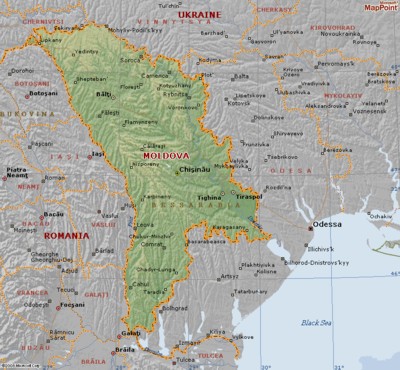- General History. Important dates and flags of Moldova.
- Kaushany in Descriptio Moldaviae by Demetrius Kantemir (Prince of Moldavia) (1714).
- Bessarabia Jews - Wikipedia.
- A Geo-Historical and Cultural Overview of Jewish Life in the Bessarabia/Moldavia Region
until the Beginning of 19th Century, Yefim Kogan, 2006. - History of Jews in Kaushany.
Some tombstones in the Jewish cemetery in Kaushany are believed to date from the 16th century. It is certain that there was a Jewish community in Kaushany in the 18th century, when Kaushany was the center of Tatar rule in southern Bessarabia. See the excerpts from Demetrius Kantemir above. In 1812, Bessarabia became a part of the Russian Empire. By 1817, 53 Jewish families lived in Kaushany. The community increased with a large Jewish immigration into Bessarabia in the 19th century. In 1853 80 families of Jewish farmers were granted landholdings by the state, and were reclassified as "state farmers."
In the 1854 Kaushany census, we find 80 Jewish families: 251 men and 272 women. Due to the difficult economic conditions, in 1864 they were permitted to get reclassified as townsmen (middle class, 'meschane'). However, a number of Jews in Kaushany continued to work in agriculture, including sheep and large cattle farmers. In 1849, two Jewish farmers owned a total of approximately one thousand heads of cattle and three thousand sheep and goats.
In 1897, 1,675 Jews lived in Kaushany, of total population of 3,729 (45%).
Kaushany between the Wars (1918-1940)
Society “Damen Ferein” (“Serene Women”), December 27, 1923
In 1930 1,872 Jews lived in Kaushany (35.1% of the total).
Five synagogues were open in Kaushany in the 1930-s, among them Shnidershe shul, the Zionist synagogue, and the Large synagogue.
After the Soviets occupied Moldova in 1940, the new authorities in Kaushany arrested Zionist leaders and people of wealth, and exiled them to Siberia. Many were killed or died shortly thereafter. At this time, all but one synagogues in Kaushany was closed down.
Kaushany during the Holocaust
When the war started on June 22, 1941 Soviet authorities in Kaushany helped the Jews escape to the east. They gave everyone documents, and helped with wagons, horses or bulls to get to the rail road station.
Those who could not or did not want to move away were handed over to the Germans or Romanians by local Moldovans. All Jews were gathered at the cemetery and burned by the Nazis. The local population assisted them in this massacre.
Only several families returned to Kaushany after the war. They left the town in the 1950-60s. The Jewish cemetery had been desecrated and destroyed during the war. In the 1950s, new apartments were build in place of a Jewish cemetery. The community was not revived after the war.
Video Testimonies of HOLOCAUST SURVIVORS from Kaushany
For more Information please visit www.college.usc.edu/vhi. (Please let me know if you have problems watching the videos, Yefim Kogan)
Marcus Leibowitz - English language - Length 00:40:15
Marcus Leibowitz was born in June 15, 1914 in Kaushany, Russia. Interview was conducted on August 16, 1995 in N. Hollywood, California, USA

|
M. Leibowitz - Part 1 and 2 (30:28 + 9.47) |
Marim Lewin nee Leibowitz - English language - Length 02:25:38
Marim Lewin was born on July 10, 1917 in Kaushany, Romania. Interview was conducted on March 7, 1997 in N. Hollywood, California, USA

|
M. Lewin - Parts 1-5 (30:26 + 29:25 + 29:59 + 29:58 + 25:50) |
Lev Bruter - Russian language - Length 01:04:56 (English subtitles will be added soon.)
Lev Bruter was born on July 16, 1923 in Kaushany, Romania. Interview was conducted on July 28, 1996 in Beer Sheva, Israel

|
L. Bruter - Parts 1-3 (28:51 + 30:27 + 05:18) |
Rafail Tabachnik - Russian language - Length 02:59:09 (English subtitles will be added soon.)
Rafail Tabachnik was born in 1920 in Kaushany, Romania. Interview was conducted on July 12, 2000 in Nesher, Israel

|
R. Tabachnik - Parts 1-6 (28:46 + 30:25 + 30:27 + 30:15 + 30:10 + 29:06) |
Basia Spiegel - English language - Length 02:59:09
Basia Spiegel was born in October 1, 1932 in Yassy, Romania. Interview was conducted on July 29, 1996 in California, USA

|
B. Spiegel |
Olga Wainberg - English language - Length 02:59:09
Basia Spiegel was born in March 13, 1935 in Yassy, Romania. Interview was conducted on December 16, 1996 in Granada Hills, California, USA

|
Olga Wainberg |


